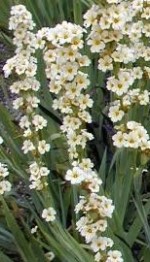 This evergreen perennial is a native of Argentina and Chile where it grows in alpine grasslands, open woods, and meadows. It is not a true grass and is in the iris family, Iridaceae, that also includes crocus, gladiolus, and freesia. Plants are clump forming and have sword-shaped, gray-green leaves that are ½ to 1 inch wide and up to eighteen inches long. The creamy-yellow flowers have golden center and are up to ¾ inches across. They are cup-shaped and produced in early summer in dense erect unbranched spikes twelve to twenty-four inches long, with each spike carrying nine to twelve flowers. Each flower has six tepals veined with dark purple stripes on the underside. The leaves may yellow after flowering and can be cut back to six inches or fertilized to improve color. Plants flower better in cool climates that in the South. The genus name, Sisyrinchium, may come from the rom the Greek sys-, meaning pig, and rynchos , meaning snout, referring to the roots being consumed by swine. The specific epithet, striatum, is the Latin word meaning striped, and refers to the markings on the tepals.
This evergreen perennial is a native of Argentina and Chile where it grows in alpine grasslands, open woods, and meadows. It is not a true grass and is in the iris family, Iridaceae, that also includes crocus, gladiolus, and freesia. Plants are clump forming and have sword-shaped, gray-green leaves that are ½ to 1 inch wide and up to eighteen inches long. The creamy-yellow flowers have golden center and are up to ¾ inches across. They are cup-shaped and produced in early summer in dense erect unbranched spikes twelve to twenty-four inches long, with each spike carrying nine to twelve flowers. Each flower has six tepals veined with dark purple stripes on the underside. The leaves may yellow after flowering and can be cut back to six inches or fertilized to improve color. Plants flower better in cool climates that in the South. The genus name, Sisyrinchium, may come from the rom the Greek sys-, meaning pig, and rynchos , meaning snout, referring to the roots being consumed by swine. The specific epithet, striatum, is the Latin word meaning striped, and refers to the markings on the tepals.
Type: Evergreen herbaceous perennial
Bloom: Creamy yellow flowers in dense spikes in early summer
Size: 12-24” H x 18” W
Light: Full sun
Soil: Average, consistently moist, very well-drained
Hardiness: Zones 4-8
Care: Divide every two to three years; dead head to control reseeding
Pests and Diseases: None of significance
Propagation: Division, seed
Companion plants: Bearded iris, Siberian iris, Achillea ‘Moonshine’, Nepeta racemosa, Geranium ‘Johnson Blue’, Ajuga
Outstanding Selections: ‘Variegatum’ (creamy white margins on the leaves; needs some protection from intense sun.)